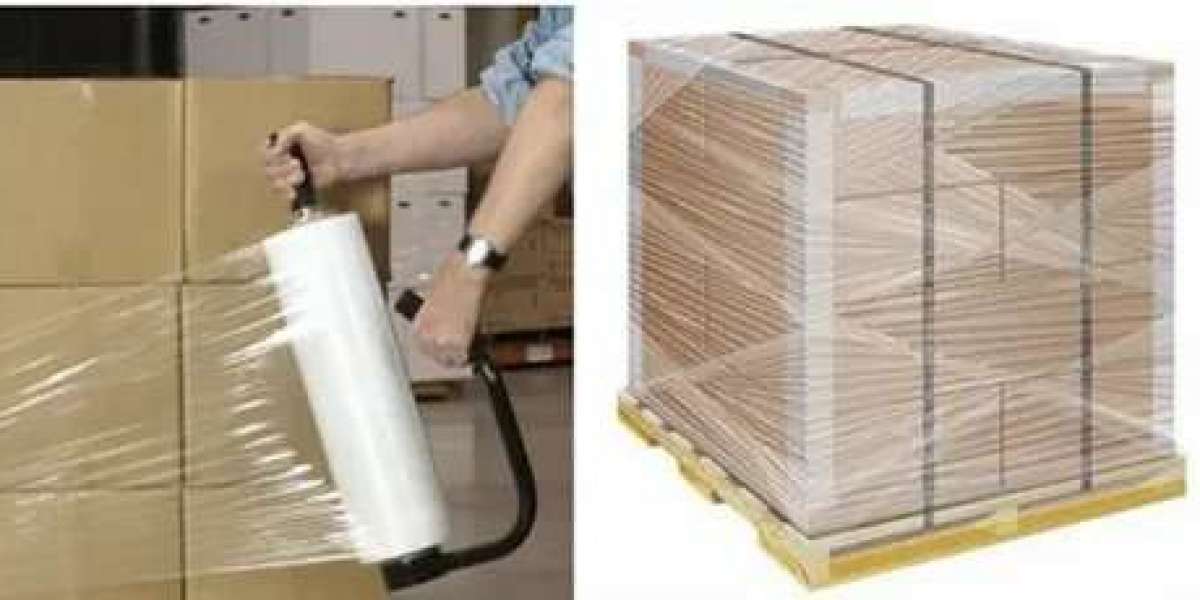Pallet wrap, often referred to as stretch wrap or shrink wrap, is a versatile and essential tool in the logistics and shipping industry. Whether you’re transporting goods locally or internationally, ensuring that your products are securely packed is crucial for preventing damage, minimizing tampering, and maintaining load stability. In this comprehensive guide, we’ll delve into everything you need to know about pallet wrap, including its types, benefits, usage techniques, and how to select the right option for your business.
What is Pallet Wrap?
Pallet wrap is a plastic film used to secure and protect products stacked on pallets. It is specifically designed to hold loads together, prevent shifting, and provide an extra layer of protection against external elements such as dust, moisture, and tampering. Pallet wrap is crucial for businesses involved in warehousing, distribution, and transportation, as it ensures that shipments remain intact from the point of origin to their final destination.
Pallet wrap is different from other packaging materials, such as strapping or pallet nets, because of its versatility and ability to conform to irregularly shaped loads. It creates a tight seal around the products, providing enhanced load stability and protecting them from environmental factors. Pallet wrap is available in various types, each offering unique features and applications, making it suitable for a wide range of packaging needs.
Key Benefits of Using Pallet Wrap
Load Stability: Pallet wrap prevents products from shifting during transport, reducing the risk of damage and ensuring that the load remains secure.
Protection Against External Elements: It shields shipments from dust, dirt, and moisture, making it ideal for goods stored in outdoor or dusty environments.
Tamper Evident: Any interference or tampering with the pallet wrap is immediately noticeable, providing an added layer of security.
Cost Efficiency: Compared to other methods like metal strapping, pallet wrap is cost-effective and requires minimal labor and equipment.
Types of Pallet Wrap and Their Uses
Choosing the right type of pallet wrap is essential to ensure maximum load stability and protection. Let’s explore the main types of pallet wrap and their unique characteristics:
1. Stretch Wrap
Stretch wrap is the most commonly used type of pallet wrap, characterized by its elasticity. It is designed to stretch and cling tightly around the pallet, providing a secure hold. Stretch wrap is available in different subtypes, such as:
Hand Stretch Wrap: Ideal for manual applications, hand stretch wrap is lightweight and easy to apply. It is best suited for small-scale operations or businesses with low-volume packaging needs.
Machine Stretch Wrap: Used with automated wrapping machines, this type is perfect for large-scale packaging operations. It offers consistent tension, speed, and efficiency, making it ideal for high-volume distribution centers.
2. Shrink Wrap
Shrink wrap is a type of plastic film that shrinks tightly around a load when heat is applied. It is commonly used for irregularly shaped products or smaller items that need to be bundled together. Shrink wrap provides a strong seal and is often used for retail packaging and smaller load units.
3. Pre-stretched Wrap
Pre-stretched wrap is a type of stretch wrap that has been pre-stretched during the manufacturing process. It requires less force to apply and provides excellent load stability. Because it uses less material, it is more economical and environmentally friendly compared to traditional stretch wraps.
How to Choose the Right Pallet Wrap
Selecting the right pallet wrap involves assessing your specific packaging needs. Here are some key factors to consider:
Type of Products Being Shipped
Evaluate the nature of your products in terms of size, shape, and weight. Heavy or bulky items may require a thicker film with higher stretch capacity, while lightweight or fragile items can be secured with a standard stretch film.
Load Stability Requirements
If your shipments are prone to shifting, consider using a high-performance stretch film that offers superior cling and elasticity. Pre-stretched films may be ideal for securing lighter loads, while machine stretch wraps are better for heavy loads.
Environmental Factors
Consider whether your pallets will be stored indoors or outdoors. For outdoor storage, opt for UV-resistant films to prevent degradation from sunlight exposure. Moisture-resistant films are also crucial for shipments exposed to high humidity.
Cost Considerations and Budget
Evaluate the cost-effectiveness of each type of wrap. While thicker films may offer better protection, they can also be more expensive. Pre-stretched films can reduce material usage and offer a more budget-friendly solution for some applications.
Techniques for Effective Pallet Wrapping
Proper pallet wrapping techniques are crucial for ensuring that your shipments remain secure during transit. Here’s a step-by-step guide for both manual and machine wrapping:
Manual Wrapping
Start at the Base: Begin wrapping at the base of the pallet to anchor the film securely.
Overlap Each Layer: Ensure that each layer overlaps the previous one by 50% to create a strong hold.
Increase Tension as You Go Up: Gradually increase the tension as you move upward to provide better stability.
Secure the Top: Once you reach the top of the load, tuck the film into itself to secure it.
Machine Wrapping
Adjust Tension and Speed: Set the machine to the appropriate tension and speed based on the type of film and load size.
Check Load Consistency: Ensure that the load is evenly stacked to prevent tipping during the wrapping process.
Use a Top Sheet: For added protection against moisture, place a top sheet over the pallet before wrapping.
.
Innovations and Trends in Pallet Wrapping Technology
The pallet wrapping industry is constantly evolving, with new technologies emerging to improve efficiency and sustainability. Here are some of the latest trends:
Smart Pallet Wrap: Smart wraps are embedded with sensors that monitor load stability and provide real-time data, improving supply chain visibility.
Biodegradable Wraps: With increasing emphasis on sustainability, biodegradable films made from renewable materials are becoming more popular.
Automated Wrapping Systems: Advanced machines equipped with AI capabilities can adjust wrapping patterns and tension settings for optimal load security.
Conclusion
Pallet wrap is an indispensable tool for businesses looking to secure and protect their shipments. By understanding the different types of pallet wrap, how to choose the right one, and implementing effective wrapping techniques, companies can ensure that their goods reach their destination in perfect condition. Whether you’re a small business or a large distribution center, investing in the right pallet wrap solution is key to optimizing logistics and minimizing costs. Implement these best practices, and you’ll achieve a secure, efficient, and sustainable packaging process that meets your business needs.








